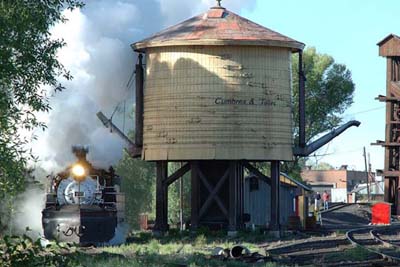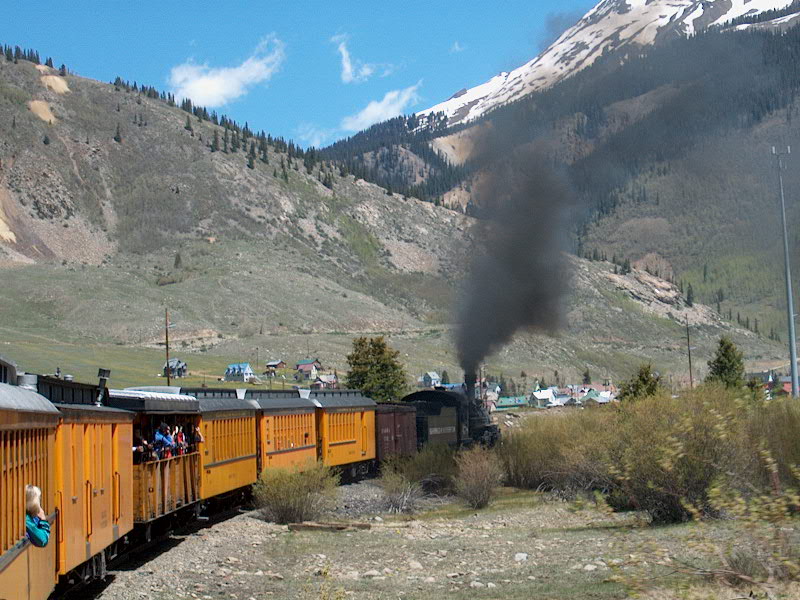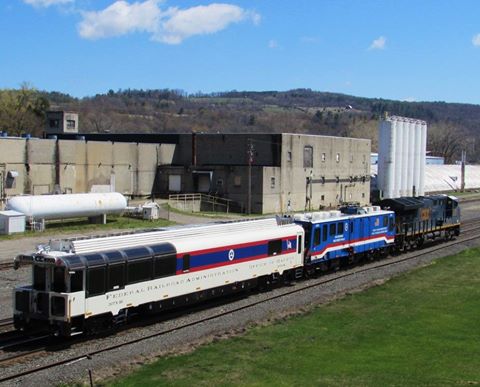|
Rio Grande Class K-36
The Denver and Rio Grande Western K-36 is a class of ten narrow gauge 2-8-2 "Mikado" type steam locomotives built for the Denver and Rio Grande Western Railroad (D&RGW) by Baldwin Locomotive Works. They were shipped to the Rio Grande in 1925 and were first used along the Monarch Branch and Marshall Pass, but were later sent to the Third Division out of Alamosa. Of the original ten, four are owned by the Durango and Silverton Narrow Gauge Railroad (D&SNG) and five by the Cumbres and Toltec Scenic Railroad (C&TSRR). Number 485 fell into the turntable pit at Salida and was scrapped in Pueblo in 1955, with many parts being saved. The locomotives are of outside-frame design, with the driving wheels placed between the two chassis frames which support the boiler, but with the cylinders, driving rods, counterweights and valve gear on the outside. This general arrangement is shared with the earlier K-27, K-28 and later K-37 Mikado engines. Designation The locomotives' designati ... [...More Info...] [...Related Items...] OR: [Wikipedia] [Google] [Baidu] |
Cumbres And Toltec Scenic Railroad
The Cumbres and Toltec Scenic Railroad, often abbreviated as the C&TSRR, is a narrow-gauge heritage railroad that operates on of track between Antonito, Colorado, and Chama, New Mexico, in the United States. The railroad is named for two geographical features along the route: the -high Cumbres Pass and the Toltec Gorge. Originally part of the Denver and Rio Grande Western Railroad's narrow-gauge network, the line has been jointly owned by the states of Colorado and New Mexico since 1970. Today, the C&TSRR is one of only two remaining parts of the former D&RGW narrow-gauge network, the other being the Durango and Silverton Narrow Gauge Railroad (D&SNG), which runs between the communities of Durango and Silverton, Colorado. The railroad has a total of ten narrow-gauge steam locomotives (six of which are operational) and two narrow-gauge diesel locomotives on its current roster. The railroad also operates two smaller former D&RGW steam locomotives, Nos. 315 and 168, for special e ... [...More Info...] [...Related Items...] OR: [Wikipedia] [Google] [Baidu] |
Durango, Colorado
Durango is a home rule municipality that is the county seat and the most populous municipality of La Plata County, Colorado, United States. The city population was 19,071 at the 2020 United States Census. Durango is the home of Fort Lewis College. History The town was organized from September 1880 to April 1881 by the Denver and Rio Grande Railroad (D&RG, later known as the Denver and Rio Grande Western railroad) as part of their efforts to reach Silverton, Colorado, and service the San Juan mining district, the goal of their "San Juan Extension" built from Alamosa Colorado. The D&RG chose a site in the Animas Valley close to the Animas River near what's now the Downtown Durango Historic Business District for its railroad facilities following a brief and most likely perfunctory negotiation with the other establishment in the area known as Animas City, two miles to the north. The city was named by ex-Colorado Governor Alexander C. Hunt, a friend of D&RG President William Jacks ... [...More Info...] [...Related Items...] OR: [Wikipedia] [Google] [Baidu] |
483 Heading To Farmington - Flickr - Drewj1946
__NOTOC__ Year 483 ( CDLXXXIII) was a common year starting on Saturday (link will display the full calendar) of the Julian calendar. At the time, it was known as the Year of the Consulship of Aginantius without colleague (or, less frequently, year 1236 ''Ab urbe condita''). The denomination 483 for this year has been used since the early medieval period, when the Anno Domini calendar era became the prevalent method in Europe for naming years. Events By place Byzantine Empire * Byzantine general Illus (''magister officiorum''), and Verina (widow of the late emperor Leo I), attempt to overthrow Emperor Zeno and place another general named Leontius on the throne. Europe * The Ostrogoths are given status as ''foederati''; they control a large part of Macedonia and Thrace (Balkans). By topic Religion * March 10 – Pope Simplicius dies at Rome after a 15-year reign, and is succeeded by Felix III as the 48th pope. He is a widower with two children. Births * X ... [...More Info...] [...Related Items...] OR: [Wikipedia] [Google] [Baidu] |
Rio Grande Class K-37
The Denver and Rio Grande Western K-37 is a class of "Mikado" type narrow-gauge steam locomotives built for the Denver and Rio Grande Western Railroad. They were all new steam locomotives rebuilt in the D&RGW Burnham Shops as a cheaper option to new Baldwin K-36s but were in fact more expensive. Burnham Shops was assisted in the construction of the class by the Stearn-Rogers Manufacturing Company. The class recycled components from Baldwin Locomotive Works built Class 19 (later C-41) 2-8-0 locomotives used on the Rio Grande's standard gauge; re-using the boiler, tender and other components salvaged from the C-41's. The engine components; particularly the frames, valve gear, wheels and counter weights , were constructed new for the locomotive class. Design The locomotives are of outside-frame design, with the driving wheels placed between the two chassis frames which support the boiler, but with the cylinders, driving rods, counterweights and valve gear on the outside. This ge ... [...More Info...] [...Related Items...] OR: [Wikipedia] [Google] [Baidu] |
D&SNG 482 2006
The Durango and Silverton Narrow Gauge Railroad, often abbreviated as the D&SNG, is a 3 ft (914 mm) narrow-gauge heritage railroad that operates on of track between Durango and Silverton, in the U.S. state of Colorado. The railway is a federally-designated National Historic Landmark and was also designated by the American Society of Civil Engineers as a National Historic Civil Engineering Landmark in 1968. The route was originally opened in 1882 by the Denver and Rio Grande Western Railroad (D&RGW) to transport silver and gold ore mined from the San Juan Mountains. The line was an extension of the D&RG narrow-gauge line from Antonito, Colorado to Durango. The last train to operate into Durango from the east was on December 6, 1968. The states of New Mexico and Colorado purchased 64 miles of track between Antonito and Chama, New Mexico in 1970, which is operated today as the Cumbres and Toltec Scenic Railroad (C&TSRR). Trackage between Chama and Durango was removed by 1971 ... [...More Info...] [...Related Items...] OR: [Wikipedia] [Google] [Baidu] |
Silverton, Colorado
Silverton is a statutory town that is the county seat, the most populous community, and the only incorporated municipality in San Juan County, Colorado, United States. The town is located in a remote part of the western San Juan Mountains, a range of the Rocky Mountains. The first mining claims were made in mountains above the Silverton in 1860, near the end of the Colorado Gold Rush and when the land was still controlled by the Utes. Silverton was established shortly after the Utes ceded the region in the 1873 Brunot Agreement, and the town boomed from silver mining until the Panic of 1893 led to a collapse of the silver market, and boomed again from gold mining until the recession caused by the Panic of 1907. The entire town is included as a federally designated National Historic Landmark District, the Silverton Historic District. Originally called "Bakers Park", Silverton sits in a flat area of the Animas River valley and is surrounded by steep peaks. Most of the peaks sur ... [...More Info...] [...Related Items...] OR: [Wikipedia] [Google] [Baidu] |
Colorado - Silverton 02
Colorado (, other variants) is a state in the Mountain states, Mountain West subregion of the Western United States. It encompasses most of the Southern Rocky Mountains, as well as the northeastern portion of the Colorado Plateau and the western edge of the Great Plains. Colorado is the List of U.S. states and territories by area, eighth most extensive and List of U.S. states and territories by population, 21st most populous U.S. state. The 2020 United States Census, 2020 United States census enumerated the population of Colorado at 5,773,714, an increase of 14.80% since the 2010 United States Census, 2010 United States census. The region has been inhabited by Indigenous peoples of the Americas, Native Americans and their Paleo-Indians, ancestors for at least 13,500 years and possibly much longer. The eastern edge of the Rocky Mountains was a major migration route for early peoples who spread throughout the Americas. "''Colorado''" is the Spanish adjective meaning "ruddy", th ... [...More Info...] [...Related Items...] OR: [Wikipedia] [Google] [Baidu] |
D&SNG 482&480 2006
The Durango and Silverton Narrow Gauge Railroad, often abbreviated as the D&SNG, is a 3 ft (914 mm) narrow-gauge heritage railroad that operates on of track between Durango and Silverton, in the U.S. state of Colorado. The railway is a federally-designated National Historic Landmark and was also designated by the American Society of Civil Engineers as a National Historic Civil Engineering Landmark in 1968. The route was originally opened in 1882 by the Denver and Rio Grande Western Railroad (D&RGW) to transport silver and gold ore mined from the San Juan Mountains. The line was an extension of the D&RG narrow-gauge line from Antonito, Colorado to Durango. The last train to operate into Durango from the east was on December 6, 1968. The states of New Mexico and Colorado purchased 64 miles of track between Antonito and Chama, New Mexico in 1970, which is operated today as the Cumbres and Toltec Scenic Railroad (C&TSRR). Trackage between Chama and Durango was removed by 1971 ... [...More Info...] [...Related Items...] OR: [Wikipedia] [Google] [Baidu] |
COVID-19 Pandemic
The COVID-19 pandemic, also known as the coronavirus pandemic, is an ongoing global pandemic of coronavirus disease 2019 (COVID-19) caused by severe acute respiratory syndrome coronavirus 2 (SARS-CoV-2). The novel virus was first identified in an outbreak in the Chinese city of Wuhan in December 2019. Attempts to contain it there failed, allowing the virus to spread to other areas of Asia and later worldwide. The World Health Organization (WHO) declared the outbreak a public health emergency of international concern on 30 January 2020, and a pandemic on 11 March 2020. As of , the pandemic had caused more than cases and confirmed deaths, making it one of the deadliest in history. COVID-19 symptoms range from undetectable to deadly, but most commonly include fever, dry cough, and fatigue. Severe illness is more likely in elderly patients and those with certain underlying medical conditions. COVID-19 transmits when people breathe in air contaminated by droplets and ... [...More Info...] [...Related Items...] OR: [Wikipedia] [Google] [Baidu] |
Federal Railroad Administration
The Federal Railroad Administration (FRA) is an agency in the United States Department of Transportation (DOT). The agency was created by the Department of Transportation Act of 1966. The purpose of the FRA is to promulgate and enforce rail safety regulations, administer railroad assistance programs, conduct research and development in support of improved railroad safety and national rail transportation policy, provide for the rehabilitation of Northeast Corridor rail passenger service, and consolidate government support of rail transportation activities. The FRA is one of ten agencies within DOT concerned with intermodal transportation. It operates through seven divisions under the offices of the Administrator and Deputy Administrator. These divisions are: Financial Management and Administration, Chief Counsel, Civil Rights, Public Affairs, Public Engagement, Railroad Policy and Development, and Safety. It has a staff of about 850. Function All passenger and freight rail ... [...More Info...] [...Related Items...] OR: [Wikipedia] [Google] [Baidu] |
San Juan Express
The ''San Juan Express'' (also known as simply the ''San Juan'') was a narrow gauge train that ran on the Denver & Rio Grande Western Railroad (D&RGW) route from Durango, Colorado via Chama, New Mexico; Cumbres Pass; and Antonito, Colorado to Alamosa, Colorado. The train ran from February 11, 1937 until January 31, 1951 as train numbers 115 and 116, though towards the end of the passenger service it took on the number 215 and 216. The railroad line was closed by the D&RGW in 1968 and much of the narrow gauge trackage has since been abandoned. A surviving portion of the narrow gauge track in the route is the long Cumbres & Toltec Scenic Railroad between Antonito and Chama which calls its westbound train the ''Colorado Limited'' and its eastbound train the ''New Mexico Express''. The line from Antonito to Alamosa is now standard gauge only and belongs to the San Luis and Rio Grande Railroad. Normally, from Alamosa to Chama, a D&RGW K-36 (Or K-37) class locomotive, either 482, ... [...More Info...] [...Related Items...] OR: [Wikipedia] [Google] [Baidu] |
Shavano (train)
The ''Shavano'', named for nearby Mount Shavano, was operated by the Denver and Rio Grande Railroad. The passenger train ran between Salida and Gunnison, Colorado on the railroad's historic narrow gauge route over Marshall Pass. The ''Shavano'' operated as Train #315 westbound (to Gunnison), and #316 eastbound (to Salida). History The original east-west main line of the Denver & Rio Grande, constructed in the 1870s and 1880s, was built as a narrow-gauge railroad, with the rails spaced three feet apart. The line ran from Denver south to Pueblo, and then turned west through the Royal Gorge to Salida. The route then continued over Marshall Pass to Gunnison, Montrose, and Grand Junction, before entering Utah and proceeding to Salt Lake City and Ogden. This existed as a through route only until 1890, when the main line was standard-gauged. The standard gauge route headed north from Salida via Tennessee Pass, rejoining the original narrow-gauge route at Grand Junction. This lef ... [...More Info...] [...Related Items...] OR: [Wikipedia] [Google] [Baidu] |








